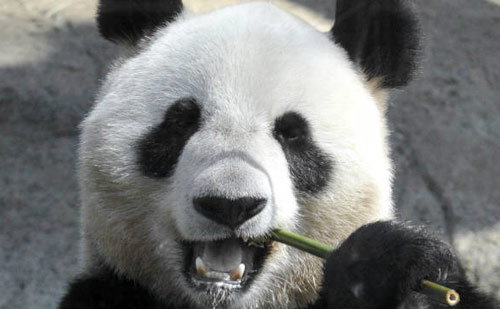|
查看原文
A giant panda slated to be the star of the first-ever live broadcast of the birth of panda cubs has lost the role -- after it was discovered the bear is not pregnant after all, Chinese state media reported.
Not only was it a phantom pregnancy, but zookeepers suspect the panda, Ai Hin, may have been faking it to improve her quality of life, the Chengdu Research Base of Giant Panda Breeding told Xinhua on Monday.
Ai Hin, age 6, had shown signs of pregnancy, including a change in appetite, moving less and an increase in progestational hormone in July, according to Xinhua.
But after almost two months, she began acting normally again, zookeepers said.
Experts say pandas sometimes carry on the behaviors associated with early pregnancy after noticing that they get preferential treatment, the news agency reported.
"After showing prenatal signs, the 'mothers-to-be' are moved into single rooms with air conditioning and around-the-clock care," Wu Kongju, an expert at the Chengdu base, is quoted as saying.
"They also receive more buns, fruits and bamboo, so some clever pandas have used this to their advantage to improve their quality of life."
The birth of Ai Hin's supposed cub and its progress in its early days, from its first cries to acquiring its distinctive black-and-white fur, were due to be broadcast online to panda lovers in China and worldwide.
Giant pandas are notoriously reluctant to breed in captivity and pseudo-pregnancies are common.
The female is fertile for no more than three days a year, and the time span for a pregnancy is from 80 to 200 days, according to the Chengdu base. Scientists will closely monitor behavioral and physiological signs, but it's often a guessing game.
Even if a pregnancy proves genuine, baby pandas have very low survival rates. According to the Chengdu base, only a third to a half of pandas born in Chinese captivity manage to survive past infancy.
There was good news last month, though, when a panda gave birth to a healthy set of triplets in China's Chimelong Safari Park in the southern city of Guangzhou. The cubs are thought to be the only living panda triplets in the world.
Edinburgh Zoo in Scotland thinks its panda, Tian Tian, could be the next to produce a cub, based on the latest scientific tests, but there are no guarantees.
"It is very likely that we will not know 100% if Tian Tian is pregnant until she gives birth," Iain Valentine, director of giant pandas for the Royal Zoological Society of Scotland, said earlier this month.
As few as 1,600 giant pandas survive in the mountain forests of central China, according to the Smithsonian Institution's National Zoo in Washington. More than 300 pandas live in zoos and breeding centers around the world, most of them in China.
|
查看譯文
一只大熊貓按計劃本能成為第一個被直播生產幼崽的明星熊貓,但沒能成功。因為人們發現這只熊貓根本沒有懷孕。
據官方的新華社8月25日報道,成都大熊貓繁育研究基地表示,這不僅僅是假想懷孕,動物園管理員懷疑大熊貓“愛浜”為了改善自己的生活質量而偽裝自己懷孕了。今年7月,6歲的“愛浜”表現出了一系列懷孕的癥狀:食欲變化、活動減少,且孕激素升高。
但兩個月之后,它就表現得很正常了,動物園管理員說。
專家稱,大熊貓有時注意到表現出早期懷孕癥狀就能得到更好的待遇時,它們就會裝作懷孕了,新華社報道。
新華社引用成都大熊貓基地專家吳孔菊(音)的話說,“一旦顯示出產前的癥狀,將要做母親的大熊貓就會被移到有空調的單間里,并享受24小時悉心照顧。”
“這些懷孕的大熊貓能獲得更多的點心、水果和竹子。一些聰明的熊貓利用這一點來改善自己的生活質量。”
如果“愛浜”生出了幼崽,幼崽的早期生活,從第一聲啼哭到長出典型的黑白色皮毛,都本應該在網上向中國和全世界的喜歡熊貓的人直播。
眾所周知,大熊貓不愿意在封閉的環境中產崽。所以偽裝懷孕的情況很普遍。
根據成都大熊貓基地的說法,雌性大熊貓一年排卵時間不超過3天,而懷孕的時間跨度則從80天到200天都有。科學家們緊密的關注著大熊貓的行為和生理特征,但很多時候還是碰運氣。
即使一只熊貓真的懷孕了,熊貓幼崽的存活率也非常低。據成都大熊貓基地統計,在中國大熊貓基地出生的大熊貓只有三分之一到一半度過了幼年期。
不過上個月有好消息,在周國南部城市廣州長隆野生動物園,一只大熊貓生出了健康的三胞胎。它們被認為是世界上唯一活著的熊貓三胞胎。
根據最近的科學檢測,蘇格蘭愛丁堡動物園認為園中的熊貓天天可能是下一個要產崽的熊貓,但并不一定。
蘇格蘭皇家動物學會的大熊貓專家伊恩·瓦倫汀(Iain Valentine)在本月初表示:“不到天天生崽之時,我們不能百分之百確定它懷孕了。”
據在華盛頓的史密森學會的國家動物園統計,在中國中部的山林里,只有1600只大熊貓存活。全世界共有300多只大熊貓生活在動物園和大熊貓繁育中心里,大部分在中國。
(譯者 ewhyou 編輯 丹妮)
掃一掃,關注微博微信
 
|


